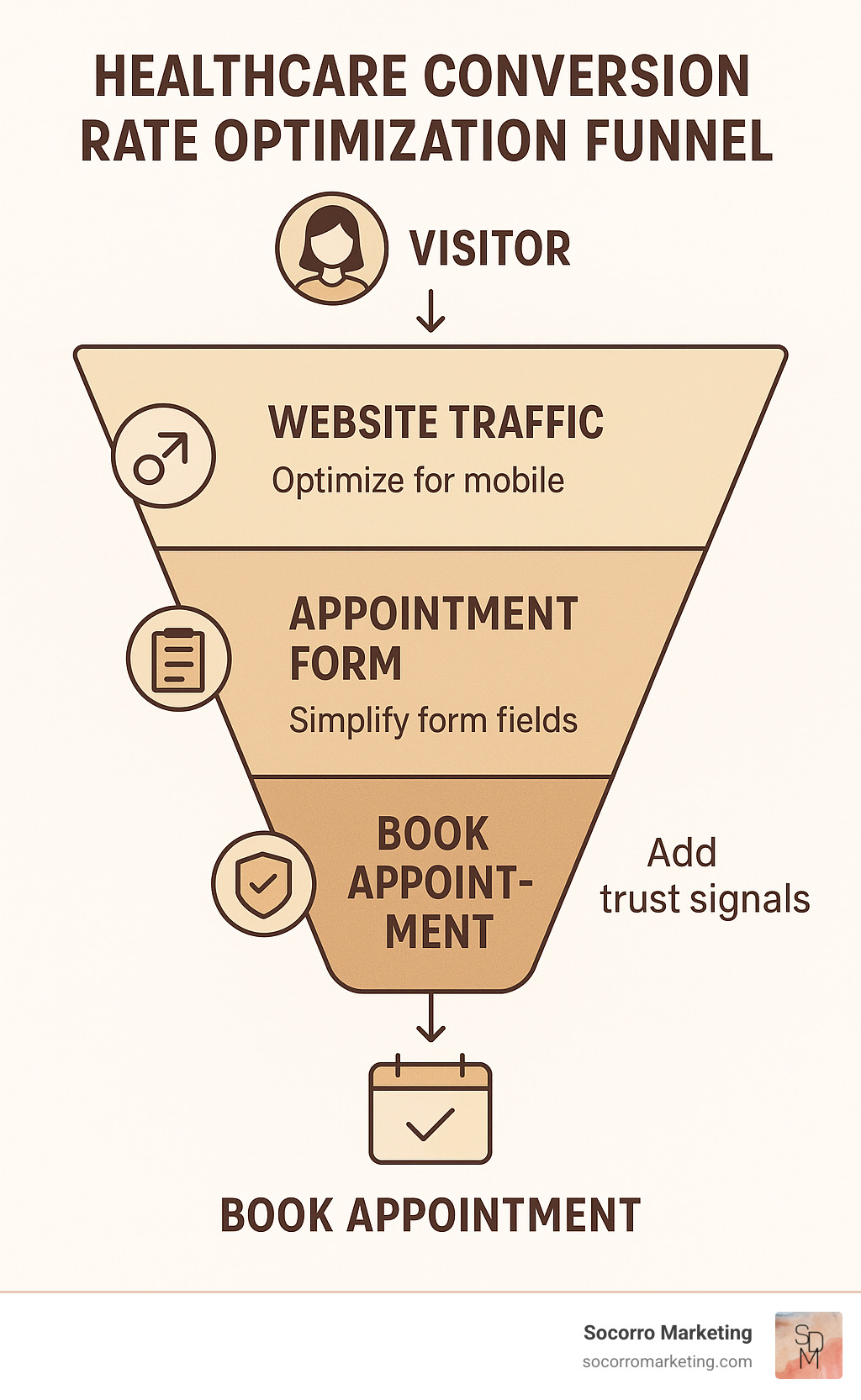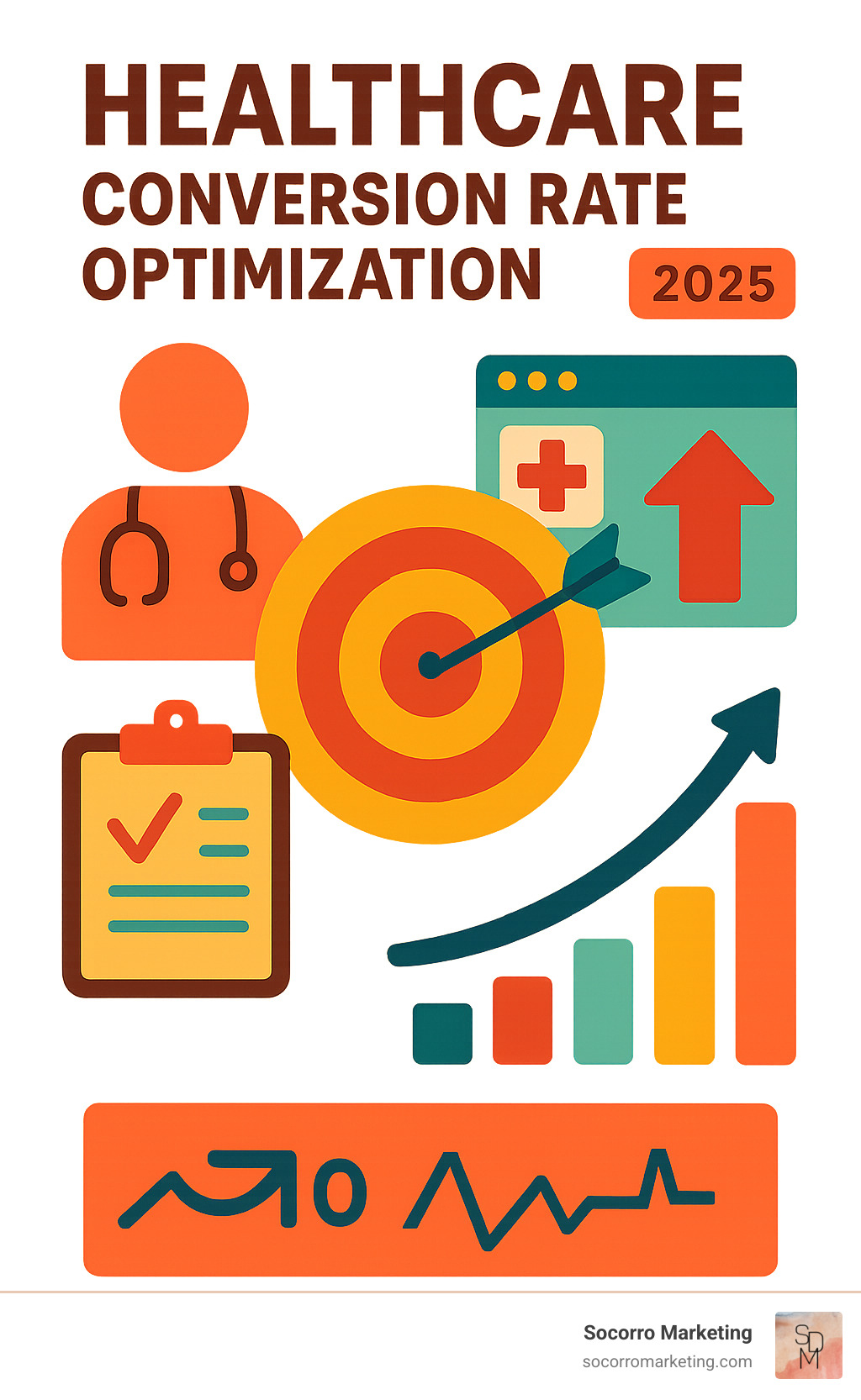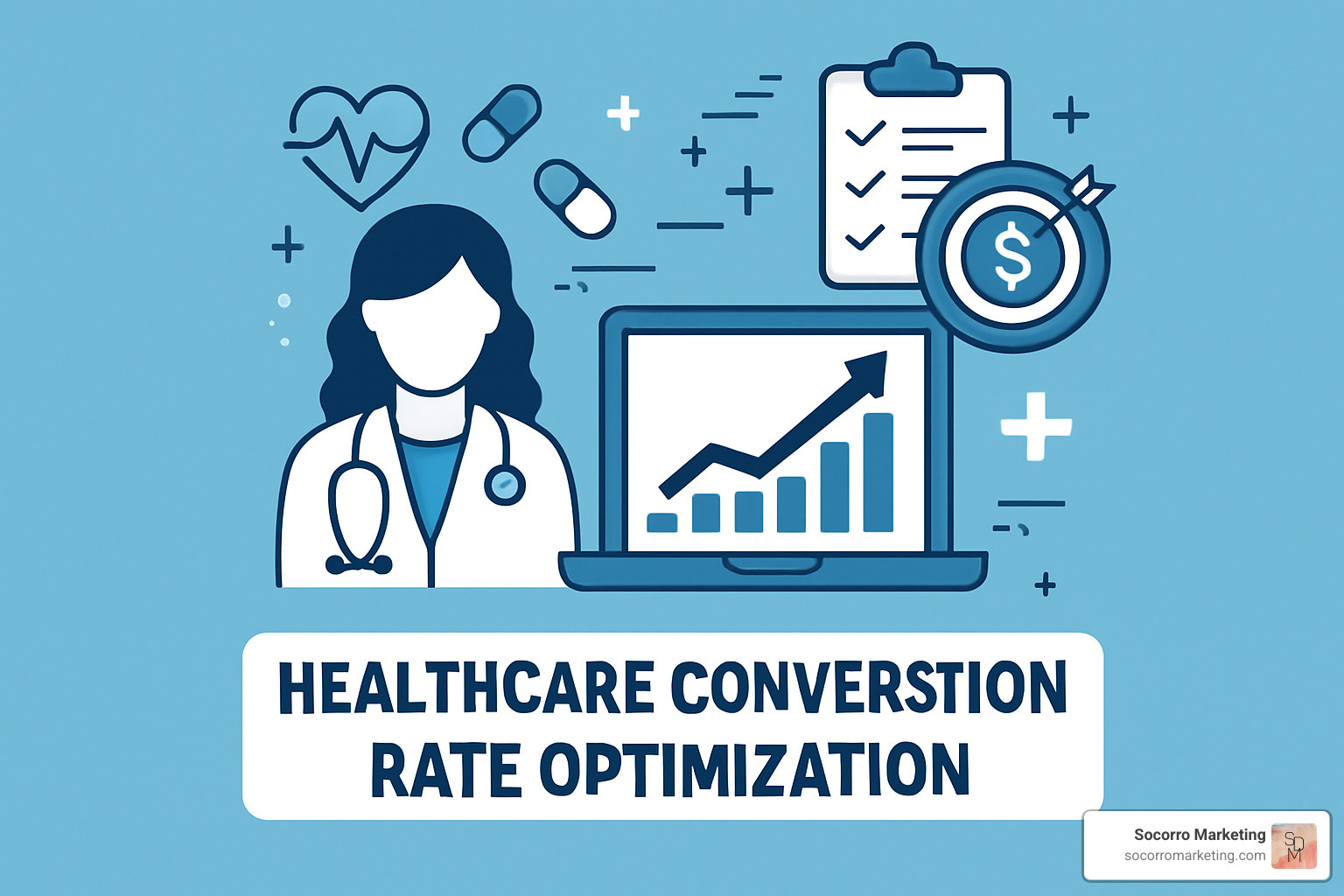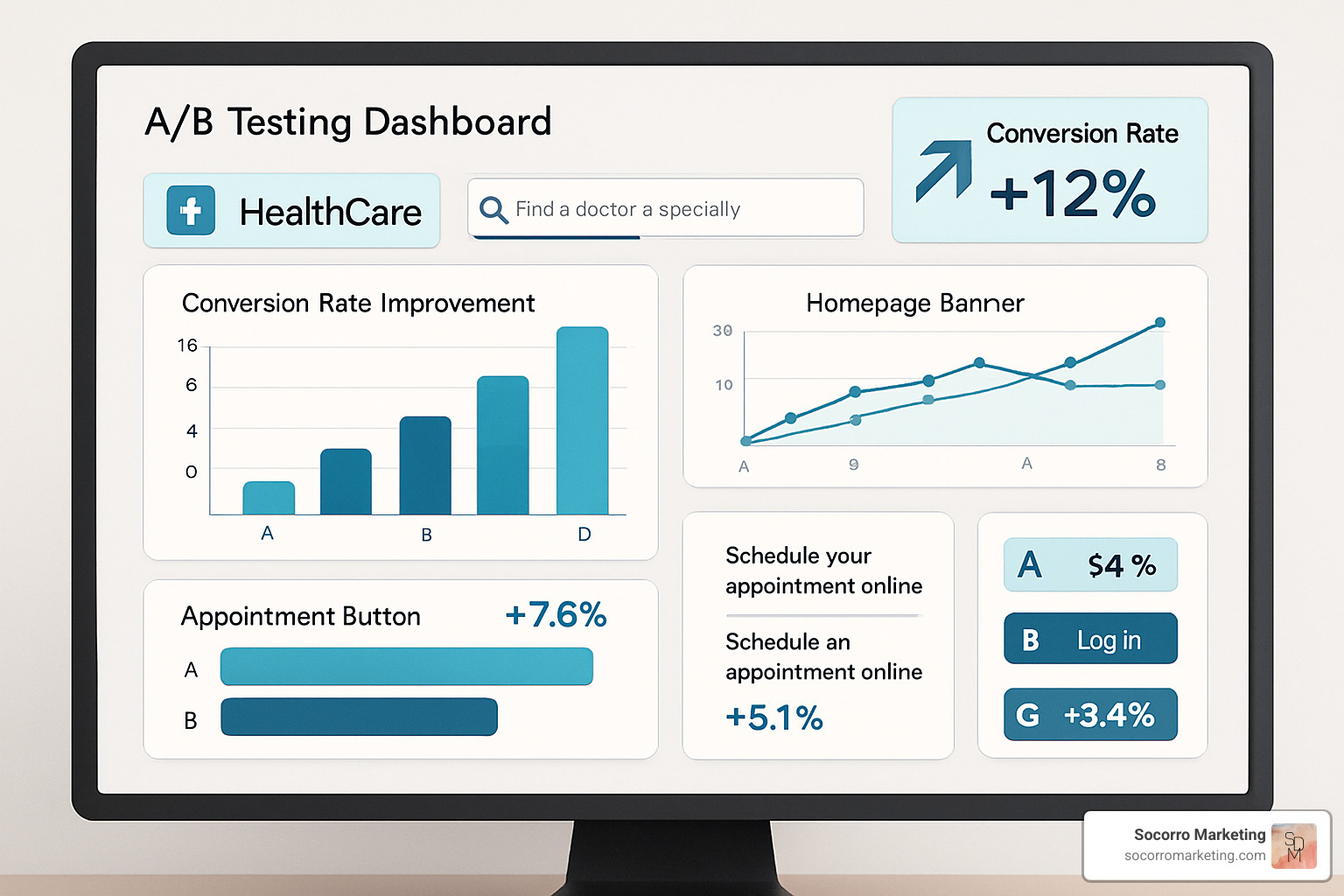Healthcare conversion rate optimization is the systematic process of improving your website and digital touchpoints to turn more visitors into actual patients. Instead of just driving traffic, CRO focuses on maximizing the value of visitors you already have.
Quick CRO wins for healthcare practices:
The reality is sobering. Research shows that 96% of your website visitors aren't ready to convert when they first land on your site. Yet the average healthcare website only converts 3% of visitors into leads or appointments.
Meanwhile, top-performing healthcare practices achieve conversion rates of 20.4% or higher - meaning they're capturing nearly 7 times more patients from the same traffic.
Poor conversion rates directly impact your bottom line. If you're spending money on Google Ads, SEO, or any marketing that drives traffic to your site, every unconverted visitor represents lost revenue and wasted ad spend.
The good news? Small improvements in conversion rates can dramatically increase patient acquisition without spending more on marketing. Companies that excel at lead generation often convert 50% more patients at 33% lower cost than their competitors.
I'm Grace Ascione, a registered nurse with an MBA who has spent over 15 years helping healthcare practices optimize their digital presence and patient acquisition strategies. My clinical background combined with Google Analytics and Google Ads certifications gives me unique insight into healthcare conversion rate optimization that bridges the gap between medical expertise and marketing effectiveness.

Healthcare conversion rate optimization is different from regular website optimization. You're not selling widgets - you're helping people make deeply personal decisions about their health and wellbeing. That changes everything.
Unlike other industries, healthcare marketing operates under strict HIPAA compliance requirements. You can't just collect any data you want or use aggressive sales tactics. Patients need time to research, compare options, and feel completely confident before they'll trust you with their care.
The importance of CRO in healthcare has never been higher. Patient acquisition costs are climbing year after year, and competition is getting fierce. Latest research on conversion UX shows that improving user experience can boost conversion rates by over 200% in healthcare settings.
Here's what makes healthcare CRO unique: trust signals matter more than flashy design. Patients want to see your credentials, read what other patients say about you, and know their information is secure.
Healthcare conversion rate optimization is the art of making it easier for the right patients to choose your practice. It's about removing friction from their decision-making process and giving them the confidence they need to take action.
The desired actions you want visitors to take typically include scheduling appointments (your main goal), calling your office for urgent concerns, filling out contact forms for general inquiries, downloading educational resources that build trust, and signing up for newsletters to stay connected.
Your conversion funnel stages follow a predictable pattern: awareness when patients find your practice, interest as they explore your services, consideration where they compare you to other options, action when they schedule or make contact, and retention where they become loyal patients who refer others.
The math is simple but powerful. If you're currently converting 3% of your website visitors and you improve that to 6%, you've effectively doubled your patient acquisition from the same marketing spend.
Cost-per-acquisition continues rising across all healthcare specialties. Google Ads costs more every year, and organic search results are increasingly competitive. In this environment, squeezing more value from your existing traffic often delivers better returns than spending more on marketing.
The competitive landscape makes CRO even more critical. Patients today research extensively before making healthcare decisions. Your website often provides their first impression of your practice. If it doesn't convert visitors effectively, they'll simply move on to a competitor whose site does.
Let's talk numbers. I know data can feel overwhelming, but understanding where you stand compared to other healthcare practices is like checking your vital signs - it tells you if you're healthy or need attention.
Here's what might surprise you: the average conversion rate for healthcare websites is approximately 3%, but this number tells only part of the story. When we dig deeper, we find that the median conversion rate for medical practitioners is actually 3.6%, while the average jumps to 7.4%.
Why the difference? It's the same reason why "average income" statistics can be misleading - a small group of top performers skews the numbers upward. In healthcare, those practices that have mastered healthcare conversion rate optimization are converting at rates so high they pull the average up significantly.
The really exciting news? The top 25% of healthcare landing pages achieve conversion rates of 20.4%. That means some practices are converting one in five visitors into patients. Imagine what that could do for your practice growth.

After analyzing thousands of healthcare websites, I've developed a simple framework to help you understand where you stand. Think of it as your conversion rate report card.
If you're converting below 3%, don't panic - but do pay attention. This means significant opportunities exist to improve your patient acquisition without spending more on marketing. Small changes can make a big difference at this level.
Converting between 3-5% puts you in average territory. You're keeping pace with most practices, but there's still plenty of room to pull ahead of your competition. This is often where practices see the biggest gains from focused optimization efforts.
Achieving 5-10% conversion rates means you're performing very well. You're ahead of most competitors and clearly doing something right. At this level, fine-tuning becomes more important than major overhauls.
Converting above 10% puts you in exceptional territory. You're in the top tier of healthcare practices when it comes to digital patient acquisition. The focus here should be on maintaining performance and scaling what's working.
These benchmarks should guide your goals, not discourage you. Every practice started somewhere, and improvement is always possible with the right approach.
Not all website visitors are created equal. Where they come from dramatically affects how likely they are to become patients. Understanding these patterns helps you invest your marketing dollars where they'll work hardest.
Paid search through Google Ads typically delivers your highest conversion rates. Why? These visitors are actively searching for your services right now. They have a problem, they're looking for a solution, and they found you. Research shows paid search can convert nearly twice as much as organic traffic for medical practices.
Organic search generally produces solid, steady conversion rates, though usually lower than paid search. The beautiful trade-off is that organic traffic doesn't cost you per click once you achieve good rankings. It's like having a 24/7 marketing team working for free.
Social media results vary widely depending on your strategy and platform. Healthcare practices often see better engagement on Facebook and Instagram for community building and patient education. These visitors might not convert immediately, but they're building trust with your practice.
Phone calls deserve special mention. While not technically a website conversion, phone inquiries generated through your online presence often convert at higher rates than form submissions. When someone picks up the phone, they're usually more motivated to take action.
The key insight? Healthcare conversion rate optimization isn't just about improving your overall numbers - it's about understanding which channels work best for your practice and optimizing accordingly.

The best healthcare conversion rate optimization strategies combine proven web design principles with the unique needs of healthcare patients. Over the years, I've seen practices double their appointment bookings by focusing on what really matters to patients: trust, convenience, and clarity.
The foundation of any successful healthcare website starts with making your call-to-action buttons impossible to ignore. Your "Book Appointment" or "Call Now" buttons should jump off the page using contrasting colors that stand out from your brand palette.
Speed matters more than you think. Healthcare websites that load in under 2 seconds convert significantly better than slower sites. When someone is in pain or worried about symptoms, they won't wait around for pages to load.
Streamlined forms are your secret weapon. Every additional form field you add increases the chance that someone will abandon the process. Start with just the essentials - name, phone number, and preferred appointment time.
Mobile-first design isn't optional anymore. With over 60% of healthcare searches happening on smartphones, your site must work flawlessly on small screens. This means large, easy-to-tap buttons, readable text without zooming, and prominent contact information.
Personalized landing pages work incredibly well in healthcare. When someone searches for "knee pain treatment," they should land on a page specifically about orthopedic services, not your general homepage.
Telehealth integration has become essential since the pandemic. Many patients prefer virtual consultations for initial visits, so prominently featuring telehealth options can capture patients who might otherwise hesitate to visit in person.
More info about content marketing benefits shows how valuable content can support your conversion optimization efforts by building trust before patients even consider booking.
Trust is everything in healthcare. Patients won't book appointments with providers they don't feel confident about. I've seen practices increase their conversion rates by 50% or more just by better showcasing their credibility.
Patient testimonials are pure gold when done right. Real patient stories that address common concerns and showcase successful outcomes can be incredibly persuasive. Just make sure they're authentic and comply with HIPAA regulations.
Detailed physician bios help patients connect with their potential doctor before they even meet. Include education, certifications, specialties, and even personal interests. When patients see that Dr. Smith also enjoys hiking and has three kids, it makes the practice feel more human and approachable.
Certifications and security badges serve as powerful trust signals. Display your medical certifications, hospital affiliations, and HIPAA compliance badges prominently. These visual cues reassure patients about your qualifications and commitment to their privacy.
Healthcare conversion rate optimization works best when it's part of your overall marketing strategy, not a separate effort. Your SEO and paid advertising campaigns should work hand-in-hand with your conversion goals.
Keyword alignment is crucial for conversion success. If someone searches for "urgent care near me," they should land on a page specifically about urgent care services, not your general family practice page.
Landing page relevance becomes even more important when you're paying for clicks. Each Google Ads campaign should direct traffic to a specific, relevant landing page rather than your homepage.
Remarketing integration helps you reconnect with visitors who weren't ready to book initially. Create targeted campaigns for people who visited specific service pages or spent significant time researching your practice.
Struggling with Google Ads? 4 Tips provides additional insights on optimizing your paid advertising campaigns to work better with your conversion optimization efforts.

The truth about healthcare conversion rate optimization: you can't just guess what works and hope for the best. Your patients deserve better than that, and so does your bottom line. The practices that consistently outperform their competitors have one thing in common - they test everything and let data guide their decisions.
I've seen too many healthcare practices make expensive website changes based on what they think looks good, only to find their conversion rates actually went down. That's why systematic testing and measurement are absolutely essential for any serious CRO effort.
A/B testing is your best friend when it comes to improving conversions. The concept is simple: show half your visitors one version of a page and half another version, then see which one performs better.
Start with hypothesis-driven testing rather than random changes. For example, "I believe that showing patient testimonials above the fold will increase appointment bookings because social proof reduces anxiety about choosing a new provider."
Sample size matters more in healthcare than in other industries. Your dermatology practice might only get 500 website visitors per month, which means tests need to run longer to achieve reliable results. Don't make decisions based on a week's worth of data - wait for statistical significance even if it takes two months.
Focus on elements that matter most to patients when deciding what to test. Try different ways of presenting your physician credentials, various approaches to explaining procedures, or alternative methods for collecting patient information.
Test one variable at a time when you're starting out. If you change your headline and your form layout simultaneously, you won't know which change drove the improvement. Master single-variable testing first, then graduate to more complex approaches.
Scientific research on website speed shows that even small improvements in loading time can significantly impact conversion rates, making page speed optimization a crucial testing priority.
Data without action is just expensive entertainment. The real value comes from turning your testing insights into systematic improvements that compound over time.
Set up iterative improvement cycles that work with your practice's rhythm. Most successful healthcare practices review their conversion data monthly and implement new tests quarterly.
Track the metrics that actually matter for your practice's success. Focus on conversion rate by traffic source to understand which marketing channels deliver the best patients, cost per acquisition by channel to optimize your marketing budget, and form completion rates to identify friction points in your patient journey.
Monitor phone call volume from organic search as a key conversion metric, since many patients prefer calling rather than filling out forms. Track average session duration on key pages to understand how engaged visitors are with your content.
HIPAA compliance remains crucial throughout your testing and analytics efforts. Ensure your analytics tools and testing platforms comply with healthcare privacy regulations.
The practices that excel at conversion optimization treat it as an ongoing discipline rather than a one-time project. By building testing and measurement into your regular operations, you create a sustainable advantage that compounds over time.
Let's address the most common questions I hear from healthcare practices when they're considering healthcare conversion rate optimization.
A conversion is simply any action that moves a potential patient closer to becoming an actual patient.
Appointment bookings are the gold standard conversion for most practices. This is what we all want - someone who's ready to schedule and show up.
Phone calls often convert at higher rates than online forms because people who pick up the phone are usually more motivated. They want to talk to a real person, ask questions, and often book on the spot.
Contact form submissions might seem less valuable, but they're actually quite important. Some patients prefer to share their concerns in writing first, especially for sensitive issues.
Educational resource downloads and newsletter signups are what we call "micro-conversions." They show interest and give you permission to stay in touch. A patient who downloads your guide to managing diabetes is much more likely to eventually book an appointment than someone who just bounces off your homepage.
The key is defining what matters most for your specific practice and tracking it consistently.
Simple changes like improving your call-to-action buttons or fixing mobile loading issues can show results within a few weeks. I've seen practices boost their conversion rates by 15-20% just by making their "Book Appointment" button more prominent.
More comprehensive changes like redesigning your appointment booking process or overhauling your service pages typically take 1-3 months to show their full impact. This is partly because you need enough data to see clear patterns, and partly because search engines need time to recognize and reward your improvements.
Website traffic volume plays a huge role in how quickly you'll see results. A busy practice with hundreds of weekly visitors will see patterns emerge much faster than a smaller clinic with dozens of visitors per week.
The most important thing is patience. Don't panic if you don't see immediate results, and don't make additional changes before your first round of improvements has had time to work.
Absolutely yes - and small clinics often see the biggest improvements from healthcare conversion rate optimization.
Many of the most effective CRO improvements don't cost money. They cost time and thoughtful planning. Making your phone number more prominent costs nothing. Simplifying your contact form costs nothing. Writing clearer, more reassuring copy about your services costs nothing but time.
Small improvements can yield big returns for smaller practices. If you're currently getting 10 new patients per month from your website and you improve your conversion rate by 50%, that's 5 additional patients. For many small clinics, that's a significant impact on revenue.
Start with the basics: make sure your website loads quickly on phones, your contact information is easy to find, and your appointment booking process is as simple as possible.
Free tools like Google Analytics and Google Search Console can give you valuable insights into where people are dropping off in your conversion funnel. You don't need expensive software to start optimizing.
Healthcare conversion rate optimization isn't some fancy marketing buzzword. It's actually one of the most practical ways to grow your practice without breaking the bank on advertising.
You're already paying for marketing that drives people to your website. Whether that's Google Ads, SEO efforts, or even word-of-mouth referrals that lead to online research, you're investing in getting visitors to your site. Healthcare conversion rate optimization simply ensures you're not wasting those investments.
The numbers tell a compelling story. When a practice improves its conversion rate from the typical 3% to just 6%, they've essentially doubled their patient acquisition without spending another penny on marketing.
The best results come from treating CRO as a continuous improvement mindset rather than a one-time project. The practices that consistently outperform their competition are the ones that regularly test, measure, and refine their patient experience.
Small changes really do compound over time. A simplified appointment form here, a clearer call-to-action button there, better trust signals throughout your site - these seemingly minor improvements work together to create significant results. Companies that excel at lead generation convert 50% more patients at 33% lower cost than their competitors.
At Socorro Marketing, our nurse-managed approach means we understand both sides of the equation. We know what patients are looking for when they're scared about a health concern, and we know what marketing tactics actually work in healthcare. That clinical perspective makes all the difference in creating conversion strategies that feel authentic and trustworthy.
The question isn't really whether you can afford to invest in conversion rate optimization. It's whether you can afford to keep letting potential patients slip through the cracks while your competitors capture them instead.
Every day you wait is another day of missed opportunities. But the good news? You can start improving your conversion rates today with simple changes that don't require a complete website overhaul or massive budget.
More info about digital marketing services can help you understand how CRO fits into your overall marketing strategy and patient acquisition goals.